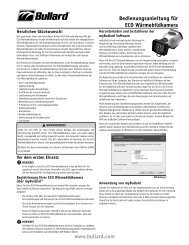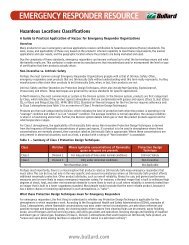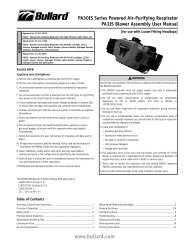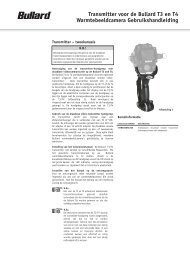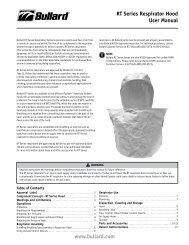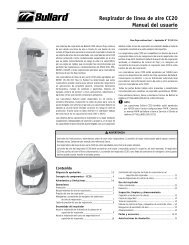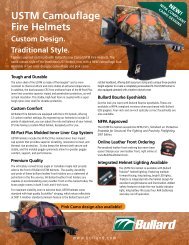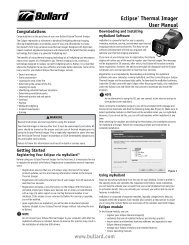PA30 Series Powered Air-Purifying Respirator for Hospital ... - Bullard
PA30 Series Powered Air-Purifying Respirator for Hospital ... - Bullard
PA30 Series Powered Air-Purifying Respirator for Hospital ... - Bullard
Create successful ePaper yourself
Turn your PDF publications into a flip-book with our unique Google optimized e-Paper software.
<strong>PA30</strong> <strong>Series</strong> <strong>Powered</strong> <strong>Air</strong>-<strong>Purifying</strong> <strong>Respirator</strong> <strong>for</strong><br />
<strong>Hospital</strong> Preparedness Applications<br />
PA3H Blower Assembly User Manual<br />
<strong>Powered</strong> <strong>Air</strong>-<strong>Purifying</strong> <strong>Respirator</strong> with High Efficiency (HE) Filters (2) – Approval No. TC-21C-0773<br />
<strong>Powered</strong> <strong>Air</strong>-<strong>Purifying</strong> <strong>Respirator</strong> with PA3NBC cartridges (3) <strong>for</strong> chlorine, hydrogen chlorine, sulfur dioxide, chlorine dioxide, hydrogen<br />
fluoride, ammonia, methylamine, and particulates – Approval No. TC-23C-2236<br />
<strong>Powered</strong> <strong>Air</strong>-<strong>Purifying</strong> <strong>Respirator</strong> with OV-AG-HE Cartridges (3) <strong>for</strong> organic vapors, chlorine, hydrogen chloride, sulfur dioxide, chlorine<br />
dioxide or hydrogen fluoride and particulates – Approval No. TC-23C-2237<br />
Intended Use:<br />
It is anticipated that individuals contaminated as a result<br />
of industrial accidents or terrorist attacks may bypass<br />
the traditional emergency medical services (EMS) and<br />
self-present at a health care facility <strong>for</strong> treatment. These<br />
individuals present multiple risks including: exposure of<br />
the healthcare workers that are providing care and<br />
treatment to the patient, exposure of other patients at<br />
the hospital, contamination of the healthcare facility itself,<br />
spreading the contamination away from the point of<br />
origin, and the financial risk in terms of the potential<br />
liability <strong>for</strong> the healthcare facility. For these reasons, it is<br />
important that there be a practical and effective system<br />
in place to decontaminate patients prior to treatment<br />
while protecting the healthcare workers.<br />
Healthcare workers per<strong>for</strong>ming this decontamination<br />
require, among other things, proper and practical<br />
respiratory protective equipment.<br />
<strong>Bullard</strong> recommends the <strong>PA30</strong> <strong>Series</strong> <strong>Powered</strong> <strong>Air</strong>-<br />
<strong>Purifying</strong> <strong>Respirator</strong> (PAPR) to meet this requirement.<br />
<strong>PA30</strong> PAPR<br />
Cautions and Limitations<br />
A. Not <strong>for</strong> use in atmospheres containing less than 19.5%<br />
oxygen.<br />
B. Not <strong>for</strong> use in atmospheres immediately dangerous to life or<br />
health.<br />
C. Do not exceed maximum use concentrations established by<br />
regulatory standards.<br />
F. Do not use respirator if airflow is less than four cfm (115 lpm)<br />
<strong>for</strong> tight fitting face pieces or six cfm<br />
(170 lpm) <strong>for</strong> hoods and/or helmets.<br />
H. Follow established cartridge and canister change schedules or<br />
observe ESLI to ensure that cartridges and canisters are<br />
replaced be<strong>for</strong>e breakthrough.<br />
I. Contains electrical parts which have not been evaluated as an<br />
ignition source in flammable or explosive atmospheres by<br />
MSHA/NIOSH.<br />
J. Failure to properly use and maintain this product could result<br />
in injury or death.<br />
K. The Occupational Safety and Health Administration regulations<br />
require gas-proof goggles to be worn with this respirator when<br />
used against <strong>for</strong>maldehyde.<br />
L. Follow the manufacturer’s user instructions <strong>for</strong> changing<br />
cartridges and/or filters.<br />
M. All approved respirators shall be selected, fitted, used and<br />
maintained in accordance with MSHA, OSHA and other<br />
applicable regulations.<br />
N. Never substitute, modify, add or omit parts. Use only exact<br />
replacement parts in the configuration as specified by the<br />
manufacturer.<br />
O. Refer to User’s Instructions, and/or maintenance manuals <strong>for</strong><br />
in<strong>for</strong>mation on use and maintenance of these respirators.<br />
P. NIOSH does not evaluate respirators <strong>for</strong> use as surgical<br />
masks.<br />
www.bullard.com<br />
WARNING<br />
Failure to follow all instructions and warnings could result in<br />
death or serious injury.<br />
Use strictly in accordance with instructions, labels and<br />
limitations pertaining to the <strong>PA30</strong> respirator.<br />
1. The <strong>PA30</strong> respirator does not supply oxygen. Use only in<br />
adequately ventilated areas containing at least 19.5%<br />
oxygen.<br />
2. Do not use when concentrations of contaminants are<br />
immediately dangerous to life or health (IDLH). This term is<br />
defined in 29CFR 1910.134 (b).<br />
3. Do not use these respirators <strong>for</strong> respiratory protection<br />
during abrasive blasting or clean up.<br />
4. Do not use in circumstances where the airborne<br />
concentration level of contaminant exceeds maximum use<br />
concentration <strong>for</strong> this type of respirator as established by<br />
regulatory standards.<br />
5. Leave area immediately if:<br />
• Breathing becomes difficult<br />
• Dizziness or other distress occurs<br />
• You taste or smell the contaminant<br />
• Unit becomes damaged<br />
• Battery alarm sounds<br />
6. This apparatus must not be worn with the blower unit<br />
switched off. If the blower is switched off, a rapid build-up of<br />
carbon dioxide and depletion of oxygen may occur, which<br />
could result in death or serious injury.<br />
7. Never alter or modify this respirator. Use only <strong>Bullard</strong> <strong>PA30</strong><br />
components and replacement parts <strong>for</strong> this respirator.<br />
Warnings and Limitations 1
Table of Contents<br />
2<br />
Table of Contents<br />
Warnings, Cautions and Limitations . . . . . . . . . . . . . . . . . . . . . . . . . . . . . . . . . . . . . . . . . . . . . . . . . . . . . . . . . . . . . . . . . . . . . . . . . . . . . . . . 1<br />
Principle of Operation . . . . . . . . . . . . . . . . . . . . . . . . . . . . . . . . . . . . . . . . . . . . . . . . . . . . . . . . . . . . . . . . . . . . . . . . . . . . . . . . . . . . . . . . . . 3<br />
Battery Pack . . . . . . . . . . . . . . . . . . . . . . . . . . . . . . . . . . . . . . . . . . . . . . . . . . . . . . . . . . . . . . . . . . . . . . . . . . . . . . . . . . . . . . . . . . . . . . . . . . 4<br />
Pre-Operational Inspection . . . . . . . . . . . . . . . . . . . . . . . . . . . . . . . . . . . . . . . . . . . . . . . . . . . . . . . . . . . . . . . . . . . . . . . . . . . . . . . . . . . . . . 4<br />
Mounting the Breathing Tube . . . . . . . . . . . . . . . . . . . . . . . . . . . . . . . . . . . . . . . . . . . . . . . . . . . . . . . . . . . . . . . . . . . . . . . . . . . . . . . . . . . . . 5<br />
Checking <strong>Air</strong> Flow . . . . . . . . . . . . . . . . . . . . . . . . . . . . . . . . . . . . . . . . . . . . . . . . . . . . . . . . . . . . . . . . . . . . . . . . . . . . . . . . . . . . . . . . . . . . . . 5<br />
<strong>Air</strong>-<strong>Purifying</strong> Elements . . . . . . . . . . . . . . . . . . . . . . . . . . . . . . . . . . . . . . . . . . . . . . . . . . . . . . . . . . . . . . . . . . . . . . . . . . . . . . . . . . . . . . . . . . 6<br />
Mounting and Replacing Cartridges . . . . . . . . . . . . . . . . . . . . . . . . . . . . . . . . . . . . . . . . . . . . . . . . . . . . . . . . . . . . . . . . . . . . . . . . . . . . . . . .7<br />
Donning the Blower . . . . . . . . . . . . . . . . . . . . . . . . . . . . . . . . . . . . . . . . . . . . . . . . . . . . . . . . . . . . . . . . . . . . . . . . . . . . . . . . . . . . . . . . . . . . 8<br />
Low Battery Alarm . . . . . . . . . . . . . . . . . . . . . . . . . . . . . . . . . . . . . . . . . . . . . . . . . . . . . . . . . . . . . . . . . . . . . . . . . . . . . . . . . . . . . . . . . . . . . 8<br />
Troubleshooting . . . . . . . . . . . . . . . . . . . . . . . . . . . . . . . . . . . . . . . . . . . . . . . . . . . . . . . . . . . . . . . . . . . . . . . . . . . . . . . . . . . . . . . . . . . . . . . 9<br />
Cleaning and Storage . . . . . . . . . . . . . . . . . . . . . . . . . . . . . . . . . . . . . . . . . . . . . . . . . . . . . . . . . . . . . . . . . . . . . . . . . . . . . . . . . . . . . . . . . . . 9<br />
NIOSH Approval Label . . . . . . . . . . . . . . . . . . . . . . . . . . . . . . . . . . . . . . . . . . . . . . . . . . . . . . . . . . . . . . . . . . . . . . . . . . . . . . . . . . . . . . . . . .10<br />
Ordering In<strong>for</strong>mation . . . . . . . . . . . . . . . . . . . . . . . . . . . . . . . . . . . . . . . . . . . . . . . . . . . . . . . . . . . . . . . . . . . . . . . . . . . . . . . . . . . . . . . . . . 11<br />
www.bullard.com
PA3H - Principle of Operation<br />
The <strong>PA30</strong> <strong>Powered</strong> <strong>Air</strong>-<strong>Purifying</strong> <strong>Respirator</strong> (PAPR) System is<br />
supplied in six parts:<br />
1. The blower assembly (Part No. PA3H) which includes:<br />
PA3BU Blower Unit<br />
PA1DB Belt Assembly<br />
PA1AFI <strong>Air</strong> Flow Indicator<br />
2. The battery pack (Part No. PA3BP). One or two packs can be<br />
used. One fully charged pack will power the blower <strong>for</strong><br />
approximately four hours.<br />
3. The breathing tube:<br />
PA3HPBT Breathing Tube Assembly with Clamp<br />
4. The cartridges (Part No. PA3NBC) offer protection <strong>for</strong> most<br />
toxic industrial chemicals and are recommended by <strong>Bullard</strong> <strong>for</strong><br />
use against chemical warfare agents. The cartridges include<br />
High Efficiency particulate filters to protect against biological,<br />
radiological, and other particulate contaminants.<br />
5. The hood with headband suspension:<br />
20SICV Hood, with Taped and Sealed Seams, and<br />
CBRN-resistant pressed polished vinyl (PVC) lens<br />
20SICVH Hood, with Taped and Sealed Seams, and<br />
CBRN-resistant pressed polished vinyl (PVC) lens <strong>for</strong> use with<br />
<strong>Bullard</strong> Hard Hat<br />
6. The Battery Charger (Part No. PA3SMC Quick Charger or<br />
PA3GC Gang Charger).<br />
<strong>PA30</strong> <strong>Series</strong> <strong>Powered</strong> <strong>Air</strong>-<strong>Purifying</strong> <strong>Respirator</strong> <strong>for</strong><br />
<strong>Hospital</strong> Preparedness Applications<br />
PA3H Blower Assembly User Manual<br />
The blower unit draws in ambient air through the cartridges. The<br />
purified air is blown into the wearer’s hood through the breathing<br />
tube. A flow indicator is provided to check that there is an<br />
adequate volume of air available to the wearer prior to use.<br />
The units are designed <strong>for</strong> use at temperatures from 10ºF to 120ºF<br />
(-12ºC to 49ºC).<br />
The system is designed to operate at a minimum air flow of 7.5<br />
cubic feet of air per minute (210 liters per minute) in the hood<br />
under normal use.<br />
The battery packs mount in compartments on the back of the<br />
blower. One fully charged battery pack will power the blower <strong>for</strong><br />
approximately four hours. Two fully charged packs will run <strong>for</strong><br />
approximately eight hours.<br />
The PA3BU is fitted with an audible alarm which will sound due to<br />
low battery power.<br />
www.bullard.com<br />
Principle of Operation 3
Battery Pack/Pre-Operational Inspection<br />
4<br />
Battery Pack<br />
A fully charged battery pack will power a blower unit to provide<br />
adequate air volume <strong>for</strong> the respirator <strong>for</strong> up to 8 hours <strong>for</strong> the<br />
PA3BU under normal working conditions, depending on whether<br />
one or two battery packs are used.<br />
To charge the battery pack, do the following:<br />
• Open the battery latch and remove the battery from the back of<br />
the blower. One or two batteries can be used.<br />
• Place each battery in the charging ports of the battery charger.<br />
Ensure that the battery contacts line up with the contacts in the<br />
charger port (see Figure 1).<br />
Figure 1<br />
• Connect the battery charger to a 115-volt AC electrical outlet.<br />
Charge the battery pack <strong>for</strong> approximately 8 hours.<br />
While the battery is charging, the light on the charger will remain<br />
on. The charger light will flash when charging is complete.<br />
The charger will then be in a “trickle” mode. The charger will allow<br />
the battery to discharge <strong>for</strong> a period of 22 hours, and charge <strong>for</strong> a<br />
period of 2 hours. This process repeats as long as the battery<br />
remains on charge in order to preserve battery per<strong>for</strong>mance and<br />
duration.<br />
A table-top gang charger with 6 ports, Part No. PA3GC, is also<br />
available.<br />
Initial Charging Procedure with Quick<br />
Charger<br />
To ensure a full charge on a new battery pack, follow these<br />
important guidelines. These guidelines also apply to battery packs<br />
that have been in storage <strong>for</strong> extended periods of time.<br />
For new battery packs or packs that have been in storage <strong>for</strong><br />
extended periods of time, follow the directions above under<br />
“Battery Pack”, and when the light begins to flash on the charger<br />
do the following:<br />
• Unplug the charger power cord. Wait 15 seconds. Plug the<br />
charger in again. The charger light will now remain on.<br />
• When the light begins flashing again, unplug the charger power<br />
cord. Wait 15 seconds. Plug the charger in again. The charger light<br />
will now remain on.<br />
The charger light will flash a third time, indicating that the battery<br />
is fully charged.<br />
This procedure should also be followed after periods of prolonged<br />
storage. Without periodic charging, the nickel metal hydride<br />
batteries will lose up to 1% of their charge per day. Allowing a<br />
battery to self-discharge during periods of prolonged storage will<br />
not damage the battery.<br />
www.bullard.com<br />
NOTE<br />
For hospital preparedness applications, the batteries<br />
should be left on charge at all times to insure adequate<br />
per<strong>for</strong>mance when needed. The nickel metal hydride<br />
batteries and quick charger have been engineered so<br />
that prolonged charging will not degrade battery<br />
per<strong>for</strong>mance or duration, however charging <strong>for</strong> periods<br />
of greater than 2 years without use may affect the<br />
per<strong>for</strong>mance.<br />
Pre-Operational Inspection<br />
Prior to each work shift, per<strong>for</strong>m the following Pre-Operational<br />
Inspection to ensure proper operation and to insure that the unit<br />
is complete.<br />
1. Belt Mounted Blower Unit, Part No. PA3BU<br />
• Check that the unit is clean and undamaged.<br />
• Inspect <strong>for</strong> deterioration, physical damage, and improper<br />
assembly.<br />
• Ensure that the canisters are properly mounted on the<br />
blower unit. Screw the cartridges into the ports until handtight.<br />
Consult your own safety professional if you have any questions as<br />
to the suitability and efficiency of the <strong>Air</strong>-<strong>Purifying</strong> Element.<br />
2. Battery Pack<br />
• Check that the battery is not damaged.<br />
• Place the battery pack in the battery compartment on the<br />
blower by first engaging the tab on the pack under the lip on<br />
the edge of the compartment. Then close the latch. Place a<br />
second battery pack in the other compartment, if desired. If<br />
only one battery is used, install the PA3BPC battery port<br />
cover over the unused port.<br />
3. Hood with Suspension or Hard Hat, or Loose Fitting<br />
Facepiece<br />
• The hood is constructed of Tychem SL. Depending on the<br />
model selected, it may be used with either a headband<br />
suspension or a hard hat.<br />
• Inspect the hood <strong>for</strong> any physical damage.
Mounting the Breathing Tube on the<br />
PA3BU Blower<br />
Ensure that a gray rubber gasket is in place in the breathing tube<br />
coupler on the blower unit (see Figure 2).<br />
Screw one end of the breathing tube into the blower unit (hand<br />
tight is sufficient) (see Figure 2).<br />
Gasket<br />
Figure 2<br />
Ensure that neither the breathing tube nor the filter is blocked.<br />
Ensure that the ON/OFF Switch is in the OFF position.<br />
Switch on the blower. If the Low Battery Alarm sounds at this time,<br />
the battery needs to be recharged. See instructions on page 4<br />
regarding properly charging the battery.<br />
NOTE<br />
The low battery alarm will sound a short beep as the<br />
power switch is cycled on and off, indicating that the<br />
alarm is functioning properly. The alarm will sound<br />
continuously to indicate low battery power.<br />
Checking <strong>Air</strong>flow with the <strong>Air</strong>flow Indicator<br />
(PA1AFI)<br />
With the blower switched ON and the filters/cartridges mounted,<br />
take the free end of the breathing tube in one hand, hold it upright<br />
and place the <strong>Air</strong>flow Indicator into the end of the tube<br />
(see Figure 3).<br />
Figure 3<br />
<strong>PA30</strong> <strong>Series</strong> <strong>Powered</strong> <strong>Air</strong>-<strong>Purifying</strong> <strong>Respirator</strong> <strong>for</strong><br />
<strong>Hospital</strong> Preparedness Applications<br />
PA3H Blower Assembly User Manual<br />
Apply a light downward pressure to the <strong>Air</strong>flow Indicator to get a<br />
reasonable seal at the breathing tube end. Ensure that the air<br />
outlet holes in the <strong>Air</strong>flow Indicator tube are not blocked. Two<br />
hands may be used if preferred, one to hold the breathing tube<br />
and one to hold the <strong>Air</strong>flow Indicator.<br />
The position of the ball in the <strong>Air</strong>flow Indicator should be<br />
observed. If any part of the ball is below the PASS LINE on the<br />
<strong>Air</strong>flow Indicator, check <strong>for</strong>:<br />
• Blower malfunction.<br />
• Clogged or damaged cartridges. See “Mounting and<br />
Replacing Canisters on the Blower Unit” on page 7.<br />
• Low battery charge or battery malfunction.<br />
If the ball is completely above the PASS LINE on the <strong>Air</strong>flow<br />
Indicator, then the system is ready <strong>for</strong> use.<br />
NOTE<br />
Due to the back-pressure of the ball, the Low Battery<br />
Alarm may sound when a reading is being taken. If the<br />
ball bounces, let it stabilize, and then read the lowest<br />
point.<br />
When the blower passes the flow test, it is ready to use.<br />
WARNING<br />
If the blower malfunctions during use in a hazardous area:<br />
DO NOT remove the respirator hood, blower or waist-belt while<br />
in the hazardous area.<br />
DO remain calm and LEAVE the hazardous area immediately.<br />
After reaching a hazard-free area, immediately remove the<br />
respirator.<br />
DO NOT use a blower that fails the flow test.<br />
This apparatus MUST NOT be worn with the blower unit<br />
switched off. If the blower unit is switched off, a rapid build-up<br />
of carbon dioxide and depletion of oxygen may occur, which<br />
could result in death or serious injury.<br />
Failure to observe these warnings could result in death or<br />
serious injury.<br />
www.bullard.com<br />
Mounting the Breathing Tube/Checking <strong>Air</strong>flow<br />
5
<strong>Air</strong> <strong>Purifying</strong> Elements<br />
6<br />
PA3BU/PA5BU <strong>Air</strong>-<strong>Purifying</strong> Elements<br />
Principle of Operation<br />
The following filter/cartridge protection classification applies when used<br />
with any of the hoods or loose fitting facepieces. In the following table<br />
“Quantity” refers to the number of filters/cartridges which must be<br />
attached to the blower unit to provide the required protection.<br />
Protection Filter/Cartridge Type Quantity NIOSH / ANSI Color Code<br />
<strong>for</strong> Cartridge Label<br />
HE PA3HE 2 Purple<br />
CL/HC/SD/CD/HF/FM/AM/MA/HE PA3NBC* 3 Olive Green and Purple<br />
OV/CL/HC/SD/CD/HF/HE PA3OVAGHE 3 Yellow and Purple<br />
*The PA3NBC cartridge provides protection <strong>for</strong> acid gases, <strong>for</strong>maldehyde, and ammonia and there<strong>for</strong>e is effective against a wide range of Toxic<br />
Industrial Chemicals. The High Efficiency (HE) Particulate Filter provides protection against airborne bacteria, viruses, and other particulates.<br />
Although not NIOSH-approved <strong>for</strong> use with the following contaminants, independent laboratories have tested and verified that the PA3NBC<br />
cartridge is effective against many chemical warfare agents and/or their recognized surrogates. These agents/surrogates are listed below.<br />
PA3NBC CARTRIDGE<br />
CHEMICAL WARFARE GAS PERFORMANCE TESTING<br />
Gas Challenge Test Flow Breakthrough Time to<br />
Concentration Rate Concentration Breakthrough<br />
DMMP 3000 mg/m3 50 lpm .04 mg/m3 >120 minutes*<br />
Sarin (GB) 4000 mg/m3 32 lpm .04 mg/m3 >120 minutes*<br />
Cyanogen Chloride (CK) 4000 mg/m3 32 lpm 8.0 mg/m3 30 minutes*<br />
Chloropicrin (PS) 15000 mg/m3 30 lpm 0.7 mg/m3 60 minutes<br />
Hydrogen Cyanide (AC) 5500 mg/m3 30 lpm 5.0 mg/m3 >30 minutes<br />
Tear Gas (CS) 23 mg/m3 64 lpm 0.4 mg/m3 >480 minutes<br />
Tear Gas (CN) 101 mg/m3 64 lpm 0.3 mg/m3 >480 minutes<br />
*These tests are part of the per<strong>for</strong>mance specifications <strong>for</strong> the C2A1 military canister. The PA3NBC Cartridge meets or exceeds the<br />
per<strong>for</strong>mance requirements of the C2A1 canister <strong>for</strong> these gases.<br />
Filters and cartridges are supplied in quantities of 6 per box.<br />
WARNING<br />
HE particulate filters are 99.97% effective against all particulate<br />
aerosols.<br />
Use only the cartridge described in the above table. Used/particulateladen<br />
cartridges must be changed as a set and not individually. All<br />
The following abbreviations are used to indicate the particulates, cartridges must be of the same type. Do not change cartridges while in<br />
gases or vapors which are removed by the gas/vapor portion of a hazardous atmosphere. Incorrect cartridge selection will invalidate all<br />
the cartridge:<br />
per<strong>for</strong>mance statements and approvals <strong>for</strong> this equipment.<br />
CL Chlorine<br />
Three (3) of the same type of cartridge must be used on the PA3BU<br />
CD Chlorine Dioxide<br />
blower unit, with the exception of the PA3HE filters which are used two<br />
HC Hydrogen Chloride<br />
(2) at a time, in conjunction with the PA3PG plug. DO NOT use the PA3PG<br />
SD Sulfur Dioxide<br />
plug to close off a port with any other cartridge type.<br />
FM<br />
AM<br />
MA<br />
HF<br />
HE<br />
Formaldehyde<br />
Ammonia<br />
Methylamine<br />
Hydrogen Fluoride<br />
High Efficiency Particulate <strong>Air</strong> Filter <strong>for</strong> <strong>Powered</strong><br />
<strong>Air</strong>-<strong>Purifying</strong> <strong>Respirator</strong>s<br />
The PA3NBC cartridges and PA3H blower should only be used with the<br />
20SICVH and 20SICV hoods. These hoods are made of Tychem SL, which<br />
has been tested by DuPont and shown to be effective against chemical<br />
warfare agents. These hoods also feature a press polished vinyl lens<br />
adequate <strong>for</strong> hospital preparedness applications.<br />
These respirators are not NIOSH-approved <strong>for</strong> use against chemical<br />
warfare agents.<br />
The respirator and cartridges should not be used beyond eight (8) hours<br />
after initial exposure to chemical warfare agents to avoid possibility of<br />
agent permeation. If liquid exposure is encountered, the respirator<br />
should not be used <strong>for</strong> more than two (2) hours.<br />
Follow established canister change schedules to ensure that cartridges<br />
are replaced be<strong>for</strong>e breakthrough occurs.<br />
Failure to follow these warnings could result in death or serious injury.<br />
www.bullard.com
Mounting and Replacing Cartridges on the<br />
Blower Unit<br />
The useful life of a chemical cartridge <strong>for</strong> vapors and gases will<br />
vary with the concentration and nature of the contaminant, the<br />
breathing rate of the respirator wearer, and ambient temperature<br />
and humidity.<br />
The Occupational Safety and Health Administration (OSHA)<br />
regulations 29 CFR 1910.134 require that the employer must<br />
implement a change schedule when using <strong>Air</strong>-<strong>Purifying</strong> respirators<br />
<strong>for</strong> protection against gases and vapors, if there is no end-ofservice-life<br />
indicator on the cartridges. The change schedule must<br />
be based on objective data that will ensure that the cartridges are<br />
replaced be<strong>for</strong>e the end of their service life. Factors to consider<br />
include workplace conditions such as contaminant concentration,<br />
relative humidity, temperature, work activities, respirator use<br />
pattern (e.g., continuous or intermittent use), presence of other<br />
contaminants, potential <strong>for</strong> contaminant migration/desorption,<br />
health effects of the gas or vapor, and the presence of any<br />
warning properties.<br />
High efficiency particulate filters must be replaced when the<br />
clogging of the filter due to retained particles reduces the air flow<br />
below the acceptable level, as indicated by testing with the <strong>Air</strong><br />
Flow Indicator. See page 5.<br />
To Replace Cartridges<br />
Remove the air-purifying element from its packaging, and inspect<br />
<strong>for</strong> damage. If in doubt do not use.<br />
Check that the air-purifying element has not exceeded its “use-by”<br />
date and that the connecting thread is in good condition.<br />
Check that the air-purifying element is appropriate to the hazard.<br />
If in doubt consult your respirator program administrator or<br />
supervisor.<br />
Check that the threads in the blower unit port are in good<br />
condition and clear of contaminant.<br />
Check that the PA3BU blower ports have the gray rubber gasket<br />
seals present.<br />
Remove the air-purifying element seals (see Figure 4).<br />
Screw the air-purifying elements into the receptacles (see<br />
Figure 5) until the cartridge is hand tight. DO NOT OVER-<br />
TIGHTEN.<br />
<strong>PA30</strong> <strong>Series</strong> <strong>Powered</strong> <strong>Air</strong>-<strong>Purifying</strong> <strong>Respirator</strong> <strong>for</strong><br />
<strong>Hospital</strong> Preparedness Applications<br />
PA3H Blower Assembly User Manual<br />
Figure 4<br />
Figure 5<br />
When using the two PA3HE filter cartridges, install the<br />
filter plug into one of the ports. DO NOT OVER-TIGHTEN<br />
(Figure 6).<br />
www.bullard.com<br />
Figure 6<br />
Mounting the Cartridges<br />
7
Donning the Blower/Low Battery Alarm<br />
8<br />
Donning the Blower and <strong>Respirator</strong> Hood<br />
Prepare to don the blower, battery and hood in a safe, hazard-free<br />
area and do the following:<br />
Check that the cartridges are properly mounted on the blower<br />
unit.<br />
Prior to assembling the system, place the battery in the battery<br />
compartment on the back of the blower. One or two battery packs<br />
may be used. (See instructions on page 4.) Fit the blower and belt<br />
around the user’s waist. With the blower at the rear of the user,<br />
adjust the belt <strong>for</strong> a com<strong>for</strong>table fit.<br />
Remove the belt and blower.<br />
Ensure that the cartridges used are suitable <strong>for</strong> the contaminant<br />
in question and are compatible with the PA3BU Blower Unit.<br />
For Hoods:<br />
Insert the Breathing Tube 5 inches into the air entry sleeve at the<br />
rear of the hood being used (see Figure 7).<br />
Figure 7<br />
Install nylon clamp over air entry sleeve and breathing tube,<br />
inserting clamp locks through two holes in plastic anchor plate<br />
that is sewn into hood. Locks should face away from user’s neck.<br />
Engage clamp locks and squeeze together until tight.<br />
Attach the other end of breathing tube to blower unit by screwing<br />
adapters together.<br />
Put on the belt and blower assembly and make any final<br />
adjustments to the belt as necessary, keeping the breathing tube<br />
and hood behind the head.<br />
Switch ON the blower.<br />
Place the hood on the head making any final adjustments to the fit<br />
as required at this time to ensure a com<strong>for</strong>table and stable fit.<br />
www.bullard.com<br />
WARNING<br />
Do not enter a hazardous area until you are sure that the blower<br />
and hood are fully operational and the blower is running. The<br />
user should periodically leave the hazardous area to check the<br />
airflow through the system. If the PA3BU Low Battery Alarm<br />
should sound, or if the user experiences any difficulty in<br />
breathing, or senses any taste or any odors from the hazard, the<br />
user should leave the hazardous area immediately. Failure to<br />
observe these warnings could result in death or serious injury.<br />
PA3BU Low Battery Alarm<br />
The PA3BU Blower unit is fitted with a Low Battery Alarm. This<br />
device will activate if the battery power is below acceptable power<br />
supply levels. The alarm is internal to the blower and the sound<br />
will be carried up the breathing tube into the hood. Sounding of<br />
the alarm indicates that insufficient airflow may be imminent. The<br />
user should immediately do the following:<br />
Leave the hazard area, remove the headpiece, disconnect the<br />
breathing tube from the hood and check the airflow with the<br />
airflow indicator (see page 5).<br />
If the airflow indicator indicates insufficient airflow, the battery<br />
should be fully charged (see “Battery Pack” on page 4), and/or the<br />
filter/cartridge should be replaced.<br />
The PA3BU Low Battery Alarm must not be solely relied upon as an<br />
indication of a low air flow condition. Only the <strong>Air</strong> Flow Indicator<br />
should be utilized <strong>for</strong> checking <strong>for</strong> adequate air flow.<br />
NOTE<br />
The PA3BU blower is provided with a circuit to protect<br />
the battery. It will not allow the battery to be discharged<br />
below a safe voltage <strong>for</strong> the cells, regardless of airflow,<br />
without the Alarm sounding. When the Low Battery<br />
Alarm sounds and the cartridges are within their useful<br />
life, the battery should be recharged to protect the<br />
battery and thereby prolong the working life of the unit.<br />
If the ball in the <strong>Air</strong>flow Indicator is BELOW or PARTLY<br />
BELOW the PASS LINE with a fully charged battery, the<br />
cartridges may need to be changed.
Troubleshooting<br />
The following guide will enable you to locate and correct malfunctions:<br />
Malfunction<br />
Low Battery Alarm is sounding, but<br />
<strong>Air</strong>flow Indicator shows adequate<br />
air flow<br />
No/low airflow into covering<br />
(Alarm sounding <strong>for</strong> low battery)<br />
Smell or taste contaminant<br />
Blower unit does not run <strong>for</strong><br />
full service life<br />
(8 hours with 2 battery packs;<br />
4 hours with 1 battery pack)<br />
Cleaning<br />
WARNING<br />
Avoid contaminant entry into the breathing tube, as this will<br />
compromise respiratory protection and could result in death or<br />
serious injury. Consult your local safety professional if you<br />
suspect that contaminant has entered the breathing tube. When<br />
cleaning the equipment, do the following:<br />
Ensure water does not enter cartridges. Replace wet cartridges.<br />
DO NOT use gasoline, organic-based solvents, or chlorinated<br />
degreasing fluids (such as trichloroethylene) as they will cause<br />
damage.<br />
DO NOT immerse the equipment in water or other cleaning fluid<br />
as this may cause contamination in the breathing tube and<br />
blower interior that will be difficult to remove.<br />
Failure to observe the instructions and warnings in this manual<br />
invalidates all per<strong>for</strong>mance statements and approvals <strong>for</strong> this<br />
equipment and could result in death or serious injury.<br />
Once cartridges have reached the end of their useful life, discard<br />
in accordance with federal, state, and local guidelines, and in<br />
con<strong>for</strong>mance with facility safety regulations.<br />
Use a lint-free cloth moistened in a mild solution of soap and warm<br />
water to clean the outer surface of the equipment.<br />
Consult the <strong>PA30</strong> <strong>Series</strong> Tychem Hood User Manual <strong>for</strong> cleaning<br />
instructions <strong>for</strong> the hood components.<br />
<strong>PA30</strong> <strong>Series</strong> <strong>Powered</strong> <strong>Air</strong>-<strong>Purifying</strong> <strong>Respirator</strong> <strong>for</strong><br />
<strong>Hospital</strong> Preparedness Applications<br />
PA3H Blower Assembly User Manual<br />
Possible Cause Solution<br />
Low Battery Re-charge battery.<br />
<strong>Air</strong> inlet to hood is twisted or constricted, Remove, inspect, and reinsert PA1BT<br />
or breathing tube inserted incorrectly Breathing Tube 5" into hood inlet.<br />
Clogged/damaged cartridge Replace the cartridge.<br />
Battery low Re-charge battery.<br />
Blower malfunction Replace blower.<br />
Breathing tube or hood damaged Replace breathing tube and/or hood.<br />
Equipment damaged or filter Leave hazardous area immediately<br />
needs to be replaced and check equipment.<br />
Replace cartridge.<br />
If the problem persists and no<br />
damage is found, return equipment<br />
<strong>for</strong> evaluation.<br />
Low airflow See above.<br />
Improper initial charge Review “Initial Charging Procedure”<br />
Prolonged storage of unit not on charger on page 4.<br />
Storage<br />
When the apparatus is completely dry, store in a clean, dry area,<br />
away from direct sunlight and sources of direct heat.<br />
The storage temperature should be between 32º F to 90º F (0º C<br />
to 32º C) with humidity less than 90% RH.<br />
Screw PA3PG port plugs into each of the three canister inlet ports<br />
and into the breathing tube outlet port<br />
Consult the CC20/<strong>PA30</strong> <strong>Series</strong> Tychem Hood User Manual <strong>for</strong><br />
storage instructions on hood components.<br />
www.bullard.com<br />
Troubleshooting/Cleaning and Storage<br />
9
NIOSH Approval Label<br />
10 <strong>PA30</strong> Approval Label<br />
<strong>Bullard</strong><br />
Cynthiana, KY 41031 USA<br />
1-800-827-0423<br />
<strong>PA30</strong> <strong>Powered</strong> <strong>Air</strong>-<strong>Purifying</strong> <strong>Respirator</strong><br />
This respirator is approved only in the following configurations:<br />
RESPIRATOR COMPONENTS<br />
CAUTIONS<br />
AND<br />
LIMITATIONS2 ALTERNATE<br />
AIR<br />
BLOWER<br />
FLOW<br />
ALTERNATE<br />
UNIT FILTER CARTRIDGE INDICATOR BATTERY BELT<br />
ACCESSORIES<br />
ALTERNATE<br />
BREATHING<br />
TUBE<br />
ALTERNATE<br />
SUSPENSION/<br />
HARD HAT<br />
ALTERNATE<br />
HOOD<br />
ASSEMBLIES<br />
TC- PROTECTION 1<br />
PA3SMC<br />
PA3PG<br />
PA1EB<br />
PA1DEB<br />
20NC<br />
ES42<br />
20LCL<br />
20LC<br />
PA3BPC<br />
20SLBTC<br />
PA1DB<br />
PA1SB<br />
PA3BP<br />
PA1AFI<br />
PA3OVAGHE<br />
PA3NBC<br />
PA3HE<br />
PA3BU<br />
PA5BU<br />
20TJN<br />
20TICN<br />
20SICN<br />
20TICSN<br />
20TICH<br />
20SICH<br />
20TPN<br />
20TPCN<br />
20LFM<br />
20LFL<br />
20SICVN<br />
20SICVH<br />
20TG<br />
20RT<br />
3000<br />
3000R<br />
5100<br />
5100R<br />
PA1BT<br />
PA1BTXS<br />
PA20LFBT<br />
PA20LFBTXS<br />
ABCFIJLMNOP<br />
ABCFHIJLMNOP<br />
ABCFHIJLMNOP<br />
21C-0773 HE X X X X X X X X X X X X X X X X X X X X X X X X X<br />
X X X X X X X X X X X X X X<br />
23C–2236 AM/CL/HC/MA/FM/HF/SD/CD/HE X X X X X X X X X X X X X X X X X X X X X X X X X X X X X X X X X X X X X X<br />
23C-2237 OV/CL/HC/HF/SD/CD/HE X X X X X X X X X X X X X X X X X X X X X X<br />
X X X X X X X X X X X X X X X X<br />
1Protection HE - High Efficiency Particulate <strong>Air</strong> Filter <strong>for</strong> <strong>Powered</strong> <strong>Air</strong>-<strong>Purifying</strong> <strong>Respirator</strong>s<br />
AM - Ammonia<br />
CD - Cholrine dioxide<br />
CL - Chlorine<br />
FM - Formaldehyde<br />
HC - Hydrogen chloride<br />
HF - Hydrogen fluoride<br />
MA - Methylamine<br />
OV - Organic Vapors<br />
SD - Sulfur Dioxide<br />
J. Failure to properly use and maintain this product could result in death or serious injury.<br />
L. Follow the manufacturer’s instructions <strong>for</strong> changing cartridges and/or filters.<br />
M. All approved respirators shall be selected, fitted, used, and maintained in accordance with MSHA,<br />
OSHA, and other applicable regulations.<br />
N. Never substitute, modify, add, or omit parts. Use only exact replacement parts in the configuration as<br />
specified by the manufacturer.<br />
O. Refer to users instructions, and/or maintenance manuals <strong>for</strong> in<strong>for</strong>mation on use and maintenance of<br />
these respirators.<br />
P. NIOSH does not evaluate respirators <strong>for</strong> use as surgical masks.<br />
2Cautions and Limitations<br />
A. Not <strong>for</strong> use in atmospheres containing less than 19.5% oxygen.<br />
B. Not <strong>for</strong> use in atmospheres immediately dangerous to life or health.<br />
C. Do not exceed maximum use concentrations established by regulatory standards.<br />
F. Do not use this respirator if airflow is less than four cfm (115 lpm) <strong>for</strong> tight-fitting facepieces or six<br />
cfm (170 lpm) <strong>for</strong> hoods and/or helmets.<br />
H. Follow established cartridge and canister change schedules or observe ESLI to ensure that<br />
cartridges and canisters are replaced be<strong>for</strong>e breakthrough occurs.<br />
I. Contains electrical parts which have not been evaluated as an ignition source in flammable or<br />
explosive atmospheres by MSHA/NIOSH.
CATALOG<br />
NUMBER DESCRIPTION<br />
Blower Assembly<br />
PA3H Blower unit with low voltage alarm and vinyl belt.<br />
Breathing tube, battery and charger sold separately.<br />
Battery Chargers<br />
PA3SMC Quick charger <strong>for</strong> PA3BP (2 ports)<br />
PA3GC Table top gang charger <strong>for</strong> PA3BP (5 ports)<br />
Replacement Cartridges<br />
PA3NBC <strong>Hospital</strong> Preparedness Cartridge (6 per box)<br />
PA3OVAGHE <strong>Hospital</strong> Preparedness Cartridge (6 per box)<br />
PA3HE High Efficiency Particulate Filters (6 per box)<br />
<strong>Respirator</strong> System<br />
<strong>PA30</strong>PREP <strong>Hospital</strong> Preparedness PAPR System includes PA3H<br />
Blower Assembly, PA3HPBT Breathing Tube,<br />
20SICVN Tychem SL Hood, 20RT Ratchet<br />
Suspension, PA3SMC Charger and set of 3 PA3NBC<br />
Cartridges.<br />
<strong>Respirator</strong> Hoods<br />
Hood with inner bib, <strong>for</strong> use with <strong>Bullard</strong> hard hat<br />
20SICVH Tychem SL, with taped and sealed seams,hard hat<br />
not included, press polished vinyl lens<br />
Hood with inner bib and long outer bib, <strong>for</strong> use with<br />
headband suspension<br />
20SICV Tychem SL, with taped and sealed seams, and<br />
20TG headband suspension, press polished vinyl<br />
lens<br />
20RT<br />
ESULTRA<br />
20SICVH<br />
20NC<br />
ES42<br />
ESRTSL<br />
20TG<br />
20SICV<br />
20SICVN<br />
TG600<br />
TGRT600<br />
3000<br />
5100<br />
<strong>PA30</strong> <strong>Series</strong> <strong>Powered</strong> <strong>Air</strong>-<strong>Purifying</strong> <strong>Respirator</strong> <strong>for</strong><br />
<strong>Hospital</strong> Preparedness Applications<br />
PA3H Blower Assembly User Manual<br />
CATALOG<br />
NUMBER DESCRIPTION<br />
20SICVN Tychem SL, with taped and sealed seams, no<br />
headband suspension, pressed polished vinyl lens<br />
Headband Suspensions and Hard Hats<br />
20TG Standard headband suspension<br />
20RT Sure-Lock ® ratchet headband suspension<br />
3000 Hard hat with standard suspension, white<br />
3000R Hard hat with ratchet suspension, white<br />
5100 Hard hat with standard suspension, white<br />
5100R Hard hat with ratchet suspension, white<br />
Accessories <strong>for</strong> Headbands Suspension and Hard Hats<br />
ESULTRA Standard replacement suspension <strong>for</strong> 3000 hard hat<br />
ESRTSL Replacement ratchet suspension <strong>for</strong> 3000R hard hat<br />
TG600 Standard replacement suspension <strong>for</strong> 5100 hard hat<br />
TGRT600 Replacement ratchet suspension <strong>for</strong> 5100R hard hat<br />
20NC Chin strap <strong>for</strong> 20TG and 20RT headband suspension<br />
ES42 Chin strap <strong>for</strong> 3000 and 5100 hard hats<br />
Replacement Parts and Accessories<br />
PA1DB Decon belt<br />
PA1DEB Extension decon belt kit<br />
PA1AFI <strong>Air</strong> flow indicator<br />
PA3BU Blower housing unit, motor and impeller<br />
PA3HPBT Breathing tube assembly; includes tube and clamp<br />
PA1BTS Breathing tube/cartridge seal<br />
PA3BP 4 hour battery pack<br />
S18051 Breathing tube clamp<br />
PA3BPC Battery port cover<br />
20SLBTC Tychem SL Breathing tube cover<br />
PA3PG Port plug <strong>for</strong> storage<br />
PA3DB<br />
➃<br />
PA1AFI<br />
PA3NBC Canisters<br />
www.bullard.com<br />
PA3HPBT<br />
PA3BU<br />
Principle of Operation 11
<strong>Bullard</strong><br />
1898 Safety Way<br />
Cynthiana, KY 41031-9303<br />
Toll free: 877-BULLARD (285-5273)<br />
Tel: 859-234-6616<br />
Fax: 859-234-8987<br />
www.bullard.com<br />
Head<br />
Protection<br />
<strong>Bullard</strong> GmbH<br />
Hochkreuzallee 36<br />
53175 Bonn-Bad Godesberg<br />
Germany<br />
Tel: +49 228 931933 0<br />
Fax: +49 228 931933 50<br />
www.bullardextrem.com<br />
<strong>Respirator</strong>y<br />
Protection<br />
Fire and Rescue<br />
Safety<br />
Thermal<br />
Imaging<br />
ISO 9001<br />
ISO 9001<br />
certified<br />
©2004 <strong>Bullard</strong>. All rights reserved.<br />
“It’s Your Life and You’re Worth It” is a trademark of <strong>Bullard</strong>.<br />
Tychem is a registered trademark of E.I. DuPont de Nemours & Company.<br />
C e rtifie d<br />
6081506398(0904)



